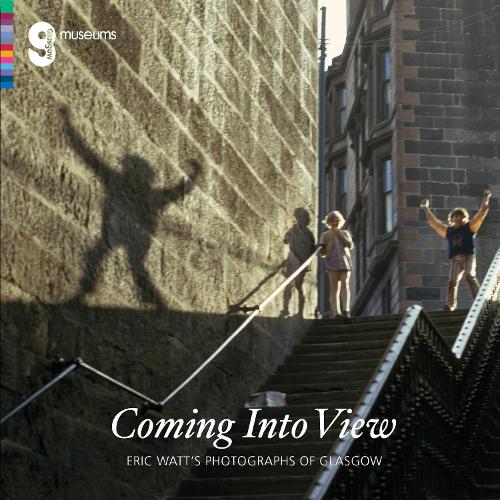COMING INTO VIEW, PHOTOGRAPHS OF GLASGOW, ERIC WATT, CURATED BY ISOBEL MCDONALD AND ALISON BROWN
Kelvingrove Art Gallery and Museum until 4 March 2023
Admission: Free
Sunday, 3pm. Eric Watt’s collection of selected fragments of city lives in Coming Into View, spanning several decades, an exhibition curated by Isobel McDonald and Alison Brown, today coalesce in the surround-sound of Kelvingrove’s organ recital. In a celebration of both Watt and Glasgow, portraits of ‘St Andrew’s Suspension Bridge’, in the damp of an all-too-familiar smirring rain, and girls with umbrellas traversing glistering tarmacadams, rivers of shining light (‘Kingston Umbrellas, 1960’), segue into street-kids sheltering from a ‘Rainy Day’ and echoey images of the Clyde with its tidal eddies (‘Fairfield’s Yard, 1965’). Collectively, they penetrate the heart of memory and imagination. But as viewers, we don’t all see the same things; view the images from that place of belonging.
Stills of colour juxtaposing with black and white offer glimpses of the comings and goings, the impermanence of what it is to be in the city not only as a person, but as a building, a bridge, a ship in the docks. We are guided through this space off the main transept by its non-chronological groupings of kids at play, construction and change, river and bridges…faith. But it’s in the in-between spaces you find yourself – where you can relate to that sense of the familiar. Stills that make you yearn for re-enactment, re-animation of those transitory moments in the past – here it is the ‘Coca-Cola Roller’ at the Garden Festival, 1988 and the first Mela, 1990.
There is nothing sentimental or contrived about them for as a visual document they reflect certain truths: ‘Bingo as Usual, 1970’ on Glasgow Green, ‘where fairs have been held since medieval times’; ‘Glasgow at Play’ in meticulous layering of lines with kids’ faces among the diagonals, verticals and horizontals of construction sites. Displays of giving and taking back, of imagined voices in the backs of tenements, open doorways, the burning exterior of a car, with flames leaping from the fender (‘Blackhill, 1972’). ‘Lyn’ with her wide, wistful smile on leaving work to get married, illuminates her frame. The head and shoulders of an unnamed fish vendor whose furrowed jowls resemble the open-gills of the ‘Fillet of Haddock’ at ‘4’6’ he’s advertising is followed by another Briggait fish vendor, a generation or so on, holding aloft the day’s catch in a mock-show of jubilation (‘Glasgow Fish Market, 1975’).
More than surfaces but hidden depths, too, with ‘St Enoch’s Underground, 1979’ exposed in a street-wide dissection, revealing its metal girding, its core of iron melding the city together. Over bridges and under them, edgelands to hang out in with pals next to the giant concrete stansions of the ‘Kingston Bridge, 1973’, whose verticality offers the perfect quiet space for talk about ambitious futures, for girls as well as for boys. The poignancy of the boy in the tyre-swing, mindful of the cover of Douglas Stuart’s Booker prize-winning novel, Shuggie Bain, its background of cranes voicing the language of change, which in another framing of the ‘Kingston Bridge’ augurs his and others dispersal to new schemes on the city’s edges.
‘Boys Playing Shop at Forth & Clyde Canal at Temple, 1960s’, in a den constructed from everyday grocery items – packing cases, tin cans, fag packets – pays homage to the canals and sinuosities and their trade links with the east. The ebullience of a wee comic in a red pinafore and stocking-soles (‘Girl at Chalk-marked Wall’) – which could just as easily be the subject for one of Joan Eardley’s many impasto renderings – is one particularly bright fragment in this mirrorball collection.
William Hume
Coming Into View Eric Watt’s Photographs of Glasgow, Isobel McDonald with contributions by Alison Brown, (Glasgow Museums Publishing, 2020) is available to buy in the gallery shop.
More information about Queen Park’s Camera Club, of which Eric Watt was a lifelong member, can be found at www.qpcc.co.uk


Leave a Reply